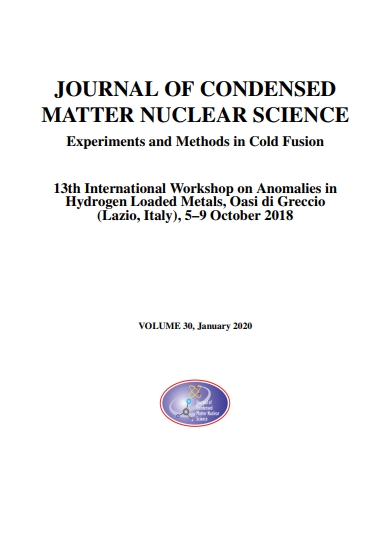期刊簡介
Journal Title:Journal Of Condensed Matter Nuclear Science
The Journal of Condensed Matter Nuclear Science (JCMNS) is an electronic journal dedicated to the field of condensed matter nuclear science. This magazine publishes research articles related to various anomalous phenomena in metal deuterated compounds and hydrides. JCMNS aims to provide a platform for discussing and showcasing experimental results and theoretical analysis in cold fusion and low-energy nuclear reaction research.
Although JCMNS may not be as good as some mainstream scientific journals in traditional academic impact indicators, it provides scientists with a space to publish and exchange research results in specific research fields. The characteristic of the journal is that it focuses on a relatively peripheral but potentially significant research field. For scientists engaged in condensed matter nuclear science research, JCMNS provides an important platform for publishing research and exploring cutting-edge scientific issues such as cold condensation. Although there is controversy in this field, the existence of JCMNS has certain value in promoting relevant scientific discussions and technological development.
中文簡介
《凝聚態(tài)核科學雜志》是一本專注于凝聚態(tài)物質核科學領域的電子期刊。該雜志發(fā)表與金屬氘化物和氫化物中的各種異常現(xiàn)象相關的研究文章。該期刊旨在提供一個平臺,用于討論和展示在冷聚變和低能核反應研究中的實驗結果和理論分析。
雖然它在傳統(tǒng)的學術影響力指標方面可能不如一些主流科學期刊,但它在特定的研究領域內為科學家提供了一個發(fā)表和交流研究成果的空間。期刊的特色在于它關注的是一個相對邊緣但具有潛在重大科學意義的研究領域.對于從事凝聚態(tài)物質核科學研究的科學家來說,其提供了一個發(fā)表研究和探索冷聚變等前沿科學問題的重要平臺。盡管這個領域存在爭議,但該期刊的存在對于推動相關科學討論和技術發(fā)展具有一定的價值。
期刊點評
Journal Of Condensed Matter Nuclear Science由The International Society for Condensed Matter Nuclear Science出版商出版,收稿方向涵蓋Energy - Nuclear Energy and Engineering全領域,平均審稿速度 ,該期刊近期沒有被列入國際期刊預警名單,廣大學者值得一試。
WOS分區(qū)(數(shù)據(jù)版本:2023-2024年最新版)
| 按JIF指標學科分區(qū) | 收錄子集 | 分區(qū) | 排名 | 百分位 |
| 學科:PHYSICS, CONDENSED MATTER | ESCI | Q4 | 79 / 79 |
0.6% |
| 按JCI指標學科分區(qū) | 收錄子集 | 分區(qū) | 排名 | 百分位 |
| 學科:PHYSICS, CONDENSED MATTER | ESCI | Q4 | 78 / 79 |
1.9% |
名詞解釋:
WOS即Web of Science,是全球獲取學術信息的重要數(shù)據(jù)庫,Web of Science包括自然科學、社會科學、藝術與人文領域的信息,來自全世界近9,000種最負盛名的高影響力研究期刊及12,000多種學術會議多學科內容。給期刊分區(qū)時會按照某一個學科領域劃分,根據(jù)這一學科所有按照影響因子數(shù)值降序排名,然后平均分成4等份,期刊影響因子值高的就會在高分區(qū)中,最后的劃分結果分別是Q1,Q2,Q3,Q4,Q1代表質量最高。
CiteScore分區(qū)(數(shù)據(jù)版本:2024年最新版)
| CiteScore | SJR | SNIP | CiteScore排名 | ||||||||||||||||||||
| 0.5 | 0.1 | 0.049 |
|
名詞解釋:
CiteScore:衡量期刊所發(fā)表文獻的平均受引用次數(shù)。
SJR:SCImago 期刊等級衡量經過加權后的期刊受引用次數(shù)。引用次數(shù)的加權值由施引期刊的學科領域和聲望 (SJR) 決定。
SNIP:每篇文章中來源出版物的標準化影響將實際受引用情況對照期刊所屬學科領域中預期的受引用情況進行衡量。
其他數(shù)據(jù)
| 是否OA開放訪問: | h-index: | 年文章數(shù): |
| 未開放 | - | 0 |
| Gold OA文章占比: | 2021-2022最新影響因子(數(shù)據(jù)來源于搜索引擎): | 開源占比(OA被引用占比): |
| 0.00% | - | |
| 研究類文章占比:文章 ÷(文章 + 綜述) | 期刊收錄: | 中科院《國際期刊預警名單(試行)》名單: |
| 0.00% | SCIE | 否 |
歷年引文指標和發(fā)文量:
更多問題
免責聲明
若用戶需要出版服務,請聯(lián)系出版商。
